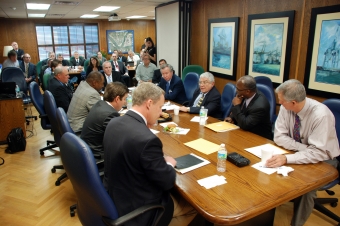Summary:
It is an activity which is focused on understanding the contractual regulation of the natural gas sector, based on the existing structure in the relationship between Brazil and Bolivia, and the distribution of gas in the state of São Paulo. In order for that, the students read in the classroom, the contract between Petrobras and Bolivia on production and gas supply. The aim was to get them used to read contracts, that means, identify the structure of a contract, the types of clauses it contains, which are the most important for the type of business conducted, and make them relate it to the context in which the contract falls and the rules of external regulation to the contractual relationship. The activity was held before the "Petrobras Case: Contract Analysis (2) - take-or-pay clauses and ship-or-pay and writing drafting."
Objective:
- GENERAL GOAL: to qualify atypical contract, how to understand it and see how the different legal regulations have influenced it.
- SPECIFIC GOAL: to know clauses of the Firm and Not Firm contracts of the natural gas sector (clauses of take-or-pay and ship-or-pay). Also, they need to understand the relationship between industry economic design and existing contractual arrangements. In addition, the goal is to make students understand the contract terms to at in a later time, fashioning new clauses for contracts. They had to learn how to read a contract (clause that matter, what is written, etc.). The Petrobras case favored two approaches: (i) discussion about the contract change, demonstrating that the legal nature of the contract may have practical implications; (ii) discuss the relationship between the contract and the external standards of it that regulate the relationship between the parties. Additionally, it also allowed the discussion of a contractual chain (involving the productive chain from gas production in Bolivia).
- It is intended that the students learn to read contracts, in which they identify the structure of a contract and the types of clauses it contains.
Dynamics:
- TEACHING METHOD: Critical reading.
- REQUIREMENTS: There was a previous required reading, but it varied according to the semesters in which the activity was applied: (i) the same text for all students, (ii) different texts for different groups in the classroom, or (iii) texts chosen by the students themselves about different topics (loan, sale, lease, etc.), since the plurality of the readings can help students to deal with different problems in the same case. There was also a further reading, that in the ministered discipline, it was a documentary about Bolivia.
- INTRODUCTION TO THE DYNAMICS: The professor made a brief introduction of the event in 10 minutes, checking with the students from some information of the case previously read, in that way the contract reflected the context and how the context was a reflection of the contractual regulation.
- DEVELOPMENT OF THE DYNAMICS: the professor divided the students into three groups of five students. The class was aimed to understand the case about the free pipeline gas access, the influence of the market and diverse arrangements that are used in this sector. The contract of Petrobras was read by the students in the classroom for 1 hour. Therefore, the professor chose the computer lab, so that the students could handle the contract on computers, including internet access. After identifying the problem, it was up to the students, in groups, discuss about it and answer the questions that have been delivered on the content (see attachment). The groups were able to discuss with each other. The professor circulated to clarify any doubts.
- END OF THE DYNAMICS: The professor made a closure in 10 minutes. The answers of the questions were to be delivered to the professor in the end. This made the comments in the beginning of the next class again in 10 minutes.
- ATTENTION IN THE CLASSROOM: The students should use the narrative data to understand the hard facts and the operation of the contracts. The professor should help students in time management. Also he/she should encourage students to answer in view of the correction criteria.
Evaluation:
- FEEDBACK: by the end of class, the professor asked the summaries made by the students. At the beginning of the next class, the professor briefly raised some questions and some topics that emerged in the synthesis, trying to present what they concluded of the contract. He discussed with students in the light of the text that they read for class
- GRADE EVALUATION: The evaluation was made on the responses received by the students, with the criteria to the problem comprehension.
Observation:
Copyright from the cover page image (cropped):
Image: "姫路港から出港する輸送船 Yu Sung", 2009, available by the Wikimedia Commons user "Corpse Reviver", under the GFDL (http://www.gnu.org/copyleft/fdl.html) or Creative Commons BY-SA-3.0 licenses.






